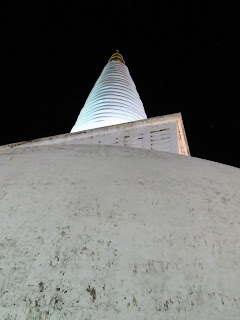

Aukana Raja Maha Viharaja was a temple named after the village near Kekirawa, somewhere close to Kalawewa man-made rainwater reservoir in north central of Sri Lanka. The temple is famous for its tallest Buddha image carved out round from a large granite rock surface leaving a narrow strip connecting to the rock boulder. The lotus pedestal placed under the statue where Buddha stands was carved out separately. The stone sculpture which is one of the best example of a standing Buddha Image from ancient Sri Lanka, is a master piece of a colossal Buddha Image by unknown sculptor .



The 13 meters high (with lotus base) standing image of Lord Buddha was believed to be enshrined in a large shrine hall measured as big as 23 meters in length by 19 meters in width. Remains of the temple walls could be seen today at site.


Though it was believed that the stone image of Buddha was built in 5th century during the reign of King Dhatusewa but inscription on the slab at the remaining shrine wall revealed that it was made in second half of 8th century. It was said that the degree of alignment was so accurate that the rain drops on Buddha's nose would straightly drop down to the small depression carved between his toes. The body proportion that based on nine times of the face length was an trigonometry followed by sculptors of 8th century.



The carving has sign of influences from Indian Arts. The Buddha's robe was skillfully carved with clear and delicate pleats without failing to show the underlying form of body. The Buddha was in Asisa Mudra blessing posture with left hand clutches to the robe at left shoulder and right hand raises up with palm facing left. His face's impassive expression gives out an aura of a spiritual supremacy.



Mirisaveti Stupa that lies further south in Anudhapura was one of the earliest monuments built to deposit the Buddha's relic. It was a distinctive monument of Buddhist tradition in Sri Lanka built by King Dutugemunu (161-137BC) in 2nd century BC. The stupa was built with brick masonry mixed with stone and mortar, placed at the center and surrounded by other virtual and residential buildings.



The 1300 years old Mirisaveti Stupa is the only structure in the country that enshrined the Buddha's relic with royal item. The legend says that King Dutugemunu (161-137BC) placed the Buddha's relic in his scepter and one day when he found that the scepter he placed at the spot could not be removed out after he returned from the bath at Tisawewa lake, he built the stupa on top of it. Scepter was a symbol of sovereignty and victory. Enshrined it under a stupa became a mark of ending the armed struggle fought for the power in the country.



The spear of King Dutugemunu with Buddha's relic were enshrined in the Relic Chamber inside the Garbha Dome, adorned with figurative and thematic murals.



In order to show the utmost respect to Mirisaveti Stupa, more and more relics and valuable items were contributed and decorations were made to adorn it by many subsequent ancient Kings of Sri Lanka. Though continuous renovation and restoration were made during Kings Gayabahu and Kasyapa period in later centuries, the original stupa still could not survive as a result of vandalism from foreign invasions and natural reasons. The existing 192 feet tall monuments was restored in year 1991 by Government of Sri Lanka funded by devoted Buddhists.



The four frontiers pieces placed at four cardinal points at the base of the Dome are significant. The ornamentation of the ancient classical stone carvings, sculptures and mural paintings are the oldest and most beautiful creation.






Some relics of Buddha and his disciples and many other sacred items were enshrined in the frontiers pieces by ancient kings.


Mirisaveti Stupa occupied the principal position in the monastery through out the glorious Anudhapura era and retained its rituals and architectural characteristic feature as a major structure in the central precinct of religious complex.




A respect visit to the resident monks in the nearby temple of Mirisaveti Stupa who is so compassion and kind to prepare a great local breakfast for us to continue our journey. He further delivered a brief dharma talk and gave me a wonderful present of a little relic stupa carved out from an elephant task. Sadhu .


Hotel and Rest House of The Sanctuary at Tissawewa was where we had our first night in Anuradhapura. It was pleasant, cozy and serene!




Beams of morning sunlight penetrated into the premises keep us warm and pleasurable.


Hotel environment provide a safe and freed home to many wild fauna like monkeys and migrating birds






A beautiful day begins from this morning!








The crystal morning dew !


A moment of touch! They have been side by side, like this, for four decades.






While admiring the great ancient trees at the premises park, we saw our vehicle coming its way to pick us up for another destination, though reluctant to leave so early, we have to bid good-bye. This is life.



The lovely lotus at Tissawewa Lake where ancient King Dutugemunu took the bath and left his spear at the site of Mirisaveti Stupa.






Lake Tesawewa, a man-made rainwater reservoir.






No comments:
Post a Comment